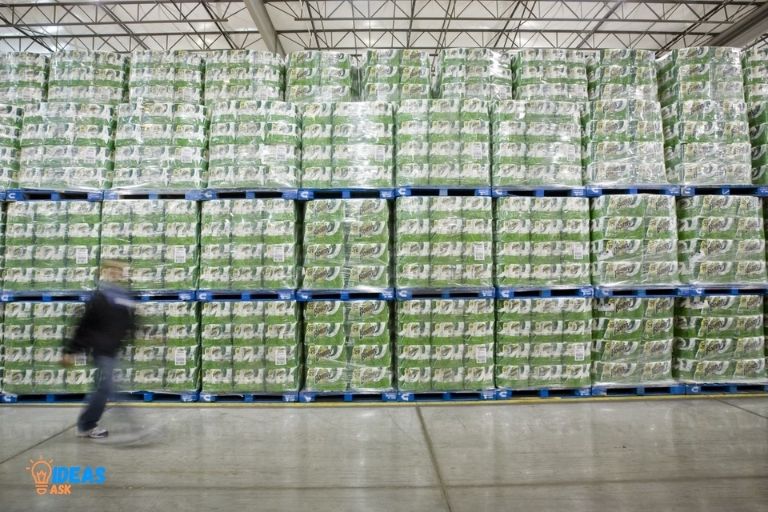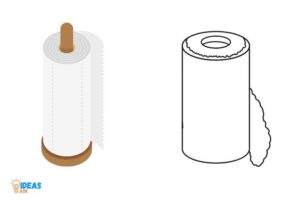How Many Paper Towels Are Used in a Year? 13 Billion Pounds
Approximately 13 billion pounds of paper towels are used in the United States each year.
Paper towels are widely used in households, offices, restaurants, and various other public spaces. They serve various purposes such as cleaning surfaces, drying hands, and absorbing spills.
The high demand for paper towels, coupled with the country’s large population, contributes to the staggering annual usage.
Paper towel consumption has a significant environmental impact, as millions of trees are cut down and large amounts of water and energy are used in their production.
Furthermore, they contribute to landfill waste and release methane, a potent greenhouse gas, when they decompose.
Adopting more sustainable alternatives like reusable cloth towels or air dryers can help in reducing the environmental footprint of paper towels.
Number of Paper Towels Used Annually
| Region | Population | Paper Towel Usage Per Person | Total Paper Towels Used in a Year |
|---|---|---|---|
| North America | 579,000,000 | 4.3 kg (9.5 lbs) | 2,493,700,000 kg (5,494,100,000 lbs) |
| Europe | 747,000,000 | 3.1 kg (6.8 lbs) | 2,315,700,000 kg (5,105,600,000 lbs) |
| Asia | 4,461,000,000 | 1.5 kg (3.3 lbs) | 6,691,500,000 kg (14,754,300,000 lbs) |
| Africa | 1,300,000,000 | 0.8 kg (1.8 lbs) | 1,040,000,000 kg (2,292,000,000 lbs) |
| South America | 653,000,000 | 2.1 kg (4.6 lbs) | 1,371,300,000 kg (3,019,800,000 lbs) |
| Oceania | 42,000,000 | 3.7 kg (8.2 lbs) | 155,400,000 kg (342,400,000 lbs) |
Key Takeaway

Five Facts About Paper Towel Usage
The Environmental Impact Of Paper Towels
According to research, people use over 13 billion pounds of paper towels every year. That’s a lot of trees that are destroyed, and a lot of waste that ends up in landfills.
In this section, we’ll take a closer look at the environmental impact of paper towels, exploring three key areas: deforestation and carbon footprint, landfill waste and methane emissions, pollution and water consumption.
Deforestation And Carbon Footprint
- Approximately 110 million trees are cut down each year to produce paper towels in the united states alone.
- Deforestation contributes to climate change as trees absorb carbon dioxide, and their removal results in an increase of this greenhouse gas in the atmosphere.
- The manufacturing process of paper towels also produces carbon emissions.
Landfill Waste And Methane Emissions
- Paper towels make up a significant proportion of waste in landfills each year.
- As paper towels decompose, they release methane gas, which is a potent greenhouse gas and contributes to global warming.
- Landfills are also becoming increasingly limited, and burying paper towels takes up valuable space that could be used for other waste.
Pollution And Water Consumption
- The production of paper towels requires large amounts of water, and the manufacturing process releases pollutants into the air and water systems as well.
- The use of bleach, which is often required to give a bright white appearance to paper towels, results in the release of toxic compounds into the environment.
- Even though many people believe that paper towels are biodegradable, most commercial paper towels are coated with a layer of plastic to improve absorbency, making them difficult to recycle.
The environmental impact of paper towels is significant. From deforestation to carbon emissions, landfill waste to water consumption and pollution, the use of paper towels has far-reaching consequences.
We can all play our part in reducing paper towel usage by using reusable alternatives, such as cloth towels or hand dryers, whenever possible. So let’s all work together to make a positive impact on our planet!
The Economics Of Paper Towels
How Many Paper Towels Are Used In A Year
Paper towels have become a staple in many households, office buildings, and public restrooms. They are convenient, quick to use and dispose of, and seem to be readily available everywhere. But have you ever stopped to consider just how many paper towels are used in a year?
Let’s take a closer look at the economics of paper towels and explore the cost of using them versus hand dryers, as well as the cost of environmentally conscious alternatives.
Annual Expenditure On Paper Towels
Paper towel usage is prevalent in many industries and settings, from restaurants and cafeterias to hospitals and hotels.
The average person in the united states uses about 3,000 paper towels each year, which equates to approximately 13 billion pounds of paper towels used annually in this country alone.
But what is the cost of using all these paper towels? According to a study conducted by the environmental protection agency (epa), the average cost of a single-use paper towel is about 2. 5 cents.
If we take the average usage of 3,000 paper towels per person each year, that equates to an annual expenditure of $75 per person on paper towels. For a family of four, that adds up to $300 per year!
Cost Of Paper Towels Vs. Hand Dryers
In recent years, the use of hand dryers as an alternative to paper towels has gained popularity, as they are often considered a more sustainable and cost-effective option. Hand dryers use significantly less energy and produce less waste compared to paper towels.
However, there is still a cost associated with hand dryers, such as installation and maintenance fees. According to experts, the average cost to install a hand dryer is around $300, and the average lifespan of a hand dryer is ten years.
Additionally, the cost of electricity for hand dryers is around 50 cents per 1,000 uses. Although there are upfront costs associated with hand dryers, investing in them can ultimately save money in the long run.
The Cost Of An Environmentally Conscious Switch
For those looking to make a more environmentally conscious switch, there are alternatives to both paper towels and hand dryers.
For example, investing in reusable cloth towels can save money and reduce waste long term. A family of four could invest in approximately 24 cloth towels for around $40, which could last several years.
Additionally, there are now sustainable options for hand dryers, such as those that use recycled paper as the drying medium rather than single-use towels.
While these options may come with an initial investment, they can ultimately save money and reduce environmental impact over time.
While paper towels may seem like a convenient and readily available option for cleaning up messes and drying hands, their cost and environmental impact add up quickly.
Consider investing in alternative options like hand dryers or reusable cloth towels to save money and reduce your carbon footprint in the long run.
Alternatives To Paper Towels
According to research, the united states alone uses about 13 billion pounds of paper towels every year. That’s a huge amount of waste that ends up in landfills. However, there are alternatives to paper towels that we can use to reduce our carbon footprint.
Here are some of the most popular ones:
Reusable Cloth Towels
One of the most sustainable alternatives to paper towels is reusable cloth towels. They are durable and can be washed and used again and again. Cloth towels can be made of various materials such as cotton, bamboo, and microfiber.
They are also often sold in bulk, which is a cheaper and more environmentally friendly option if you plan on using them frequently.
Some key benefits of reusable cloth towels are:
- They are reusable and create less waste.
- They can be purchased in bulk and are affordable in the long run.
- They come in different materials that can be tailored to fit individual needs.
Air Hand Dryers
Air hand dryers are another excellent alternative to paper towels. They use hot air to dry hands and do not require any paper waste. In addition, they are often found in public restrooms and can be used by multiple people without the need for cleaning or maintenance.
Some key benefits of air hand dryers are:
- They require no paper waste, making them an eco-friendly option.
- They are often found in public restrooms and can be used by multiple people.
- They are touchless, making them more hygienic than paper towels.
Compostable Paper Towels
If you still want to use paper towels but want to reduce your impact on the environment, compostable paper towels are an option. These towels are made from plant-based materials and can be added to your compost bin instead of ending up in a landfill.
Some key benefits of compostable paper towels are:
- They are made from plant-based materials and are therefore eco-friendly.
- They can be composted, reducing a significant amount of waste.
- They can still be used for their intended purpose, making them a practical option.
By choosing any of these alternatives to paper towels, we can take a step toward reducing our carbon footprint and creating a sustainable future.
Reducing Paper Towel Waste In Public Spaces
Paper towels are ubiquitous in public spaces like schools, offices, and airports, leading to substantial waste that can significantly harm the environment.
Here are several strategies that can help us reduce paper towel consumption and make public spaces greener.
Awareness And Education
The first step towards reducing paper towel waste in public spaces is to raise awareness and educate people about the environmental impacts of paper towels.
Here are some key points to consider:
- Encourage people to opt for reusable hand towels or dryers instead of paper towels.
- Make sure that the instructions for using dryers or reusable towels are clearly visible.
- Spread awareness on the financial and environmental benefits of decreasing paper towel waste.
Transitioning To Environmentally-Friendly Alternatives
Using environmentally-friendly alternatives to paper towels is another sustainable option. Here are some key points about transitioning to these options:
- Recycled paper towels and biodegradable napkins are environmentally-friendly alternatives to regular paper towels.
- Consider sourcing towels and napkins made from bamboo or other eco-friendly materials.
- Encourage businesses and institutions to switch to more sustainable options.
Increasing Access To Hand Dryers
Hand dryers are a sustainable alternative to paper towels, but they are not yet widely available in many public spaces.
Here are some key points about increasing access to hand dryers:
- Installing hand dryers in public spaces, such as schools, airports, and offices, can significantly reduce paper towel waste.
- Hand dryers are more cost-effective than continually purchasing paper towels.
- Encouraging institutions to invest in hand dryers can eventually help them save resources and money.
By adopting these strategies, we can reduce paper towel waste in public spaces and set the foundation for a more sustainable future.
FAQ About Paper Towel Usage
How Many Paper Towels Are Used In A Year On Average?
According to studies, an american uses 2,400 to 3,000 paper towels a year.
How Do Paper Towels Harm The Environment?
Paper towels come from trees, which means they contribute to deforestation. Also, their production requires a lot of water and energy.
What Are Some Environmentally-Friendly Alternatives To Paper Towels?
Cloth towels, sponges, and reusable microfiber towels are environmentally-friendly alternatives to paper towels.
How Can I Reduce My Paper Towel Usage?
Try to use fewer paper towels by opting for cloth towels or reusable microfiber towels. Or, simply reduce the amount of paper towels you use per usage.
Conclusion
Overall, understanding the impact of paper towel usage on the environment and on our wallets is crucial. The amount of paper towels used in a year by an average household, business, or country may seem trivial, but when you consider the larger picture, the consequences are undeniable.
From deforestation to greenhouse gas emissions, to overflowing landfills, the environmental impact is profound. However, it is not too late to make a change.
By implementing small changes like using reusable towels, air-drying hands, or purchasing recycled paper products, we can significantly reduce our paper towel usage and minimize our impact on the earth.
As consumers, we hold the power to make a positive impact on our environment while also saving money in the long run. It is up to us to take action and make a difference.





